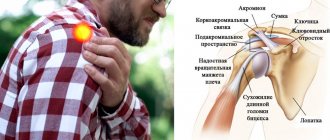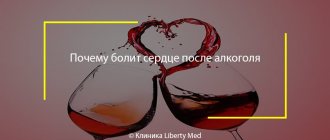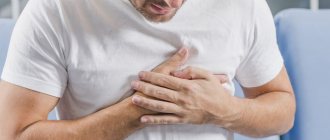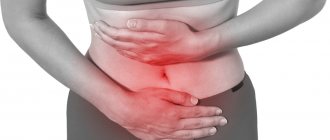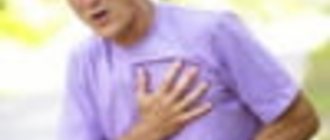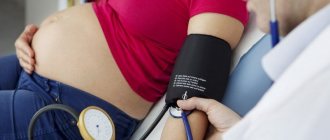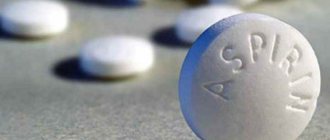Causes of pain
If you take all the clinical cases and add a little theoretical knowledge, you can find out why the child has an unpleasant sensation in the heart area.
- Functional pain. Most often observed in primary schoolchildren and adolescents. At this time, the final formation and growth of organs occurs, and hormonal fluctuations occur.
- In adolescence, the symptom appears against the background of vegetative-vascular dystonia, due to pressure fluctuations.
- Cardialgia develops against the background of a viral or bacterial infection. With such diseases, the load on the heart increases (pulse increases, temperature rises). But in this case, I cannot exclude such a complication as myocarditis.
- I often met in practice children who complained of pain in the heart, but in fact they were diagnosed with pathologies of the spine, problems with digestion, and bile ducts. And the sensations on the left side of the chest were simply irradiation from the main source.
- The left chest may hurt after an injury or bruise.
- Finally, unpleasant sensations can be associated directly with diseases of the heart muscle, pericardium and blood vessels. In this case, a complete examination of the child’s heart is necessary (taking a dynamic cardiogram or monitoring it, echocardiography, general blood tests and biochemistry).
Causes of pain in the heart area
Among non-cardiac reasons:
- diseases of the spine;
- diseases of the gastrointestinal tract - the child has pain in the heart area due to irradiation of pain from the stomach;
- vegetative-vascular dystonia;
- emotional experiences;
- neurological disorders, etc.
If we talk about diseases of the heart and blood vessels, the reasons may be:
- myocarditis;
- endocarditis;
- pericarditis;
- rheumatism;
- aortic aneurysm, etc.
There is no need to panic - the best thing you can do is to go to a specialist as soon as possible.
Features of symptoms at different ages
For each child, depending on his age, there are specific clinical manifestations, and parents need to know about this. Only in this case is it possible not to miss pathologies, the treatment of which should begin immediately, without waiting for irreversible consequences.
In infants, preschoolers and primary school students
When an infant has a heartache, he will not be able to talk about it. But if the baby becomes lethargic, has difficulty latching on the breast, is choking, and at rest the pulse remains rapid, then this condition cannot be ignored. There may be a congenital defect or myocarditis.
Up to 7 years of age, if a child complains of pain in the heart, then most likely the cause is the functioning of the internal organs (this happens when there is congestion in the gallbladder). Rapid growth and development of the vascular, respiratory and digestive systems may be associated with stabbing, but short-lived sensations.
Sometimes pain behind the sternum occurs during physical activity. After 11 years of age, pain in the heart area in children is often caused by pressure fluctuations due to vegetative-vascular dystonia. They do not depend on the position of the body and occur even in complete rest. But they often intensify under the influence of nervous tension or fear. In such cases, it is necessary to consult a child psychotherapist.
Quite severe pain accompanies changes in the spine. Sitting at a desk for a long time and at home at the computer, and lack of physical activity, which I often observe in modern children, lead to curvature. Pinched nerve bundles very reliably simulate cardialgia.
The child often begins to feel pressure or stabbing in the area of the heart as a result of a stressful situation. This is how the nervous system reacts to moving and a change of environment, a new school, or separation of parents. In this case, complaints arise immediately or some time after stress. They should not be ignored; it is necessary to explain the problem that has arisen in the family on your own or seek help from a psychologist.
Such children are often brought to the local doctor with complaints of pain, poor appetite, and sleep disturbances. In such cases, doctors like to diagnose “VSD”. The whole truth about this syndrome and an expert view of the problem are available in the video at the link below.
In teenagers
Now let's figure out why a child may experience cardialgia during adolescence. The restructuring of all organs and systems and hormonal surges make him very susceptible to all traumatic situations. Therefore, the problem may arise during the exam, under the influence of strong negative emotions.
Heart disease in children: what parents should be wary of.
1. In 2021, 211 children died in physical education lessons. If you subtract vacations, holidays and weekends from 273 school days, it turns out that every day a child died in one of the Russian schools. From a medical point of view, sudden death in children can be caused by various reasons - both cardiological with the development of acute heart failure, and diseases of the central nervous system. Parents may not even know that their child has such a problem. However, everything can be diagnosed with a timely visit to a pediatric cardiologist.
2. According to the medical examination plan, at 1 year, then at 3 years (before kindergarten) and 6–7 years (before school), children must undergo a medical commission, which includes a cardiologist, who is obliged to refer the child for standard studies - EchoCG and ECG. EchoCG (or ultrasound of the heart) allows you to evaluate the functioning of the heart, its anatomical structure, the contractility of the ventricles, and measure the pressure in the cavities, which is necessary to exclude congenital and acquired anomalies of the heart and lungs. An ECG analyzes the functioning of the conduction system of the heart and identifies its disorders, including life-threatening ones. If a child is suspected of having an arrhythmia, the doctor will refer him for further examination - daily ECG monitoring and consultation with a pediatric arrhythmologist.
3. With some undiagnosed heart defects, tragedy can occur even with average physical exertion. But it’s even more dangerous when under-examined children, trying to earn points before admission, decide to pass the GTO standards, which require absolute health and serious preparedness. Therefore, doctors insist that before passing the GTO standards and competitions, children undergo a full cardiac examination (echocardiography, stress ECG, daily ECG monitoring) to exclude life-threatening disorders in the heart.
4. Often, after suffering from viral diseases, myocarditis (inflammation of the heart muscle) and inflammation of the blood vessels of the heart (aortitis, coronaritis) develop. This leads to a decrease in the contractility of the myocardium, disruption of its blood supply (including the conduction system of the heart), to the development of heart failure and life-threatening arrhythmias. Therefore, after recovering from a viral infection (especially a severe one), the child should be released from physical education for two weeks and must undergo an ECG.
5. The causes of fainting can be associated with both cardiac dysfunction (cardiac arrest, vegetative-vascular dystonia), and with pathology of the central nervous system (tumors, epilepsy), diseases of the endocrine system (hypoglycemia, diabetes mellitus), abnormal development of the spine (Kimmerle anomaly) etc.
6. The cardiovascular system of a rapidly growing child's body is extremely vulnerable. In adolescence, many children develop vegetative-vascular dystonia of the vagotonic type - a condition in which there is a tendency to hypotension. A sharp drop in blood pressure can lead to fainting, in which unsuccessful falls can cause fatal brain damage. Therefore, if a child complains of dizziness, headache, or periodically loses consciousness, be sure to consult a specialist and undergo the necessary examination.
7. Another problem is the special nutrition system that teenagers who are concerned about their figure choose. They eliminate fats from the diet and replace meals with protein shakes. However, the exclusion of one food component provokes the early and rapid development of atherosclerosis of the coronary arteries, leading to myocardial ischemia, the development of acute heart failure and sudden cardiac arrest.
8. There are many children who have had heart surgery at an early age. But they lead a normal life. They participate in sports clubs, as they say, without fanaticism, for their health. But to practice, they, like other children, need to get a certificate from a cardiologist.
9. What parents should be wary of:
- Blue discoloration of the nasolabial triangle and the area around the eyes is a sign of deterioration of venous outflow and insufficient blood oxygen saturation.
- Pain in the heart, shoulder blade, left arm.
- Persistent hypothermia is a low body temperature.
- Shortness of breath, which occurs due to blood stagnation and oxygen starvation.
- Cold palms and feet.
- Fatigue after physical activity - the child sits down, sighs, and complains of palpitations.
- Fainting.
10. It must be remembered that hypertension is rarely asymptomatic. Children complain of headaches, dizziness, weakness, fatigue, blurred vision or spots before their eyes. Children with hypertension often have sharply reduced vision. It is very important not to attribute these complaints to overwork, but to consult a doctor in time. The initial forms of childhood hypertension are corrected without medication. Results can be achieved if you normalize the child’s weight, daily routine (the student needs to get enough sleep, he should not get tired or overexcited) and nutrition. It is very important to choose suitable physical activity. The best results are achieved by cardio training (fast walking - 30-40 minutes daily, swimming, cross-country skiing, cycling).
11. But strength training for children with hypertension is absolutely contraindicated. If these measures do not produce results, medications are prescribed, the doses of which are selected individually and can only be discontinued by a doctor.
12. Most often, increased blood pressure worries children in adolescence (13–16 years). Blood pressure standards in children vary depending on age, weight (overweight children have higher blood pressure), height (short children have lower blood pressure) and gender (boys have higher blood pressure than girls). In children under 14 years of age, the average pressure should not exceed 120/80 mm Hg. Art., for older ones – 135/85 mm Hg. Art. Make an appointment with the cardiologist of the Children's Department, Anna Yuryevna Kozhina, by phone. 43-03-03 and 41-03-03 or
Nature of pain and pathology
It is important to consider in more detail the main causes of heart pain, which are associated with pathological processes in the body. The strength and severity of sensations, the time of its appearance and the provoking factor play an important role in diagnosis.
Stitching pain usually occurs in the following cases:
- pressure changes due to dystonia;
- neurosis;
- penetration of air into the pleural cavity of the left lung;
- pericarditis;
- rachiocampsis;
- heart disease, myocardial dystrophy, coronary blood flow disturbance.
Pressing pain in the left chest often accompanies severe abnormalities and may be a sign of:
- pericarditis;
- myocardial ischemia;
- aneurysms;
- congenital abnormalities in the structure of valves and coronary vessels.
It is important to understand that children who complain of heart pain are not always just trying to attract the attention of their parents. It cannot be ruled out that the child is telling the truth. In this case, it is best to play it safe and undergo a full examination.
Symptoms or signs of a heart attack in teenagers
Some signs may be noticed several days before severe chest pain is felt, including:
- Difficulty breathing.
- Chest discomfort, cough that does not go away.
- Nausea, upset stomach, abdominal pain, heartburn.
- Pain that spreads to the arm.
- Dizziness.
- Sore throat or jaw, vomiting.
- Snoring, cold sweat.
- Arrhythmia.
- Swollen legs, feet and ankles.
During a sudden attack, it is important to take immediate action, call an ambulance and take the teenager to a doctor.
Ambulance
Case from practice
Parents came for a consultation with a 13-year-old child who complained of stabbing pain in the heart area.
Appeared several months ago; previously I was ill only with colds. When collecting anamnesis, it became clear that an unpleasant sensation appears after eating, especially when eating fatty and heavy foods. It is accompanied by symptoms such as nausea and sometimes vomiting. No abnormalities were found on the ECG. A consultation with a gastroenterologist and an ultrasound of the liver showed a violation of the outflow of bile from the bladder and its inflammation. The boy was referred to a gastroenterologist.
Pain in the heart when taking a deep breath, causes
Every second person wonders why my heart hurts when I inhale? The appearance of this symptom is influenced by several factors that are worth paying attention to. Among them is pneumothorax. When taking a deep breath, the heart hurts if the patient develops pneumothorax. This is a diagnosis in which a large amount of air penetrates into the pleural cavity. Often, upon diagnosis, a patient develops a complication, even with effective treatment.
The disease is caused to develop in two cases:
- Traumatic pneumothorax. Air enters the lungs during a fall, injury, or injury.
- Damage to lung tissue. The lungs begin to function incorrectly, which is what causes pneumothorax.
The pain of pneumothorax is cutting and pulling. It gets worse when laughing, when inhaling and when talking. Associated symptoms include depression, fear, arrhythmia, changes in blood pressure, cough, general weakness, and pallor. If neglected and untreated, it leads to tuberculosis, lung tumors and other complications.
Most often occurs in males in adulthood. Pneumothorax also appears when flying to high altitudes, when diving to depths and serious injuries.
- Intercostal neuralgia. Intercostal neuralgia occurs when pinched nerves are irritated and can also cause severe pain in the heart. The nature of the pain is sharp and pulling. The patient feels unpleasant sensations constantly, they intensify. The pain is localized in the heart and ribs. Stops when taking painkillers or changing position. Intensifies with breathing, coughing and sneezing. Sometimes accompanied by sharp tingling and burning in the ribs. With intercostal neuralgia, there are no cardiac symptoms other than pain in the heart. Blood pressure and pulse are within normal limits. This disease is not dangerous if treated on time. More often observed in mature people. Medication treatment using injections and droppers is attributed.
- Precordial syndrome. With precordial symptoms, heart pain is the main symptom. The nature of the pain syndromes is acute and sharp. Lasts for two minutes and stops. After this, the patient is again disturbed. When breathing, the discomfort intensifies. Sometimes the aching pain lasts for several hours and only stops when taking painkillers. Precordial syndrome most often appears at the age of twenty. It is not life-threatening during treatment and with timely assistance. Treatment in a hospital is necessary to monitor the patient’s condition and monitor dynamics. In untreated cases, the patient is prescribed drug treatment at home with bed rest.
- Dry pleurisy. We are talking about inflammation of the pleura. It also causes pain syndromes in the heart area. Pleurisy appears when ribs are broken, bruises and other injuries. Unpleasant sensations appear when inhaling, when changing posture and when moving. Does not pose a danger to human life. The causes of pleurisy include pneumonia, benign and malignant tumors, bronchial asthma, abscess, heart attack and other diseases. Tuberculosis can also be a concomitant diagnosis.
Expert advice
If a child begins to complain of heart pain, I usually advise calming down and trying to figure out what it might be related to. First you need to put him on the bed, then sit him down, ask him to bend over, and take a deep breath. Cardiac pathology usually does not depend on changes in body position. If a child talks about increased pain when bending over, most likely we are talking about a pinched nerve root in the spine due to its structural disorders. Pain when breathing can occur with inflammatory pathology of the respiratory system. But when a child often has heart pain, the discomfort is burning or pressing, what to do in this case? It is important not to delay diagnosis and treatment. For this purpose, you should contact your pediatrician. After the necessary examinations (ECG, X-ray, EchoCG), it will be possible to determine the causes of the symptoms and take measures. You should consult a doctor immediately if heart pain in children is accompanied by:
- high temperature;
- cough, shortness of breath;
- severe weakness;
- lack of appetite;
- nausea and vomiting;
- constipation or diarrhea;
- arrhythmia;
- blue or pale skin;
- increase or decrease in pressure;
- deterioration of the condition after physical activity.
Dear parents, how many of you have encountered similar problems when a child complained of heart pain, and how were they solved in practice? Share your experience - it may help others.
How often does your heart hurt?
